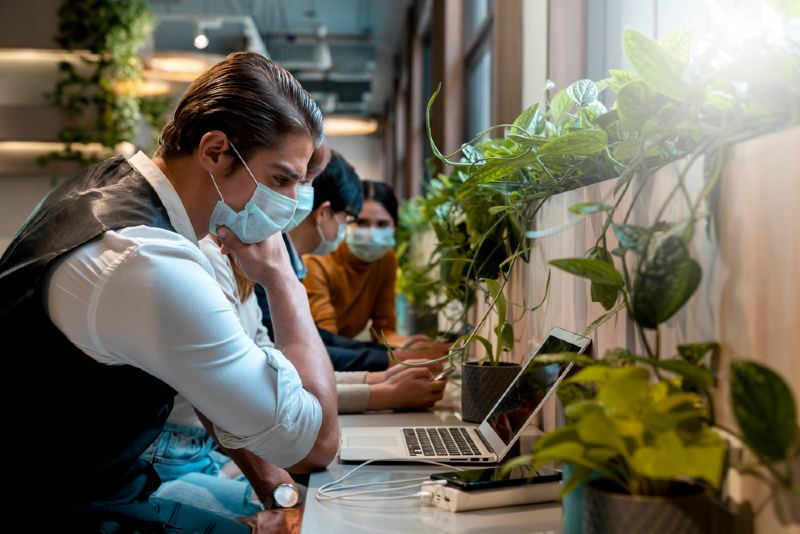Are you one of the small business owners who pivoted earlier this year to remote operation amid the coronavirus pandemic and are now confronting the return to work dilemma? It’s an increasingly common situation these days. Should you stay remote (some businesses are still paying rent for unused office space) or return to your workplace? When trying to make that decision, however, it brings up a host of other questions, including:
Can you return to work safely?
Are your employees ready to come back?
Do you feel confident you can provide a safe working environment for yourself, your staff, your clients and customers?
If you are struggling with these issues, you are not alone. And there are workplace tools and solutions available that may decide between returning to work a bit easier.
I recently talked with David Palmieri, DVP/GM of Product Management at ADP. Palmieri says they started hearing from clients back in the summer who were looking for tools to help them manage the getting-back-to-work process and create an environment where everyone felt safe.
Palmieri points out the challenges posed by the COVID-19 crisis were unique, and there weren’t any ready-to-go solutions “laying around” that could be immediately implemented. But, he says, ADP and other large companies were facing the same dilemma, so
“we rallied to bring tools to market” and got to work creating innovative solutions that were built right into ADP’s HR and payroll platform.
Realizing businesses of all sizes could benefit from the same solutions, they just had to be scaled for easy use. ADP created a Return to Workplace dashboard designed for small businesses.
One of the biggest concerns business owners had was finding out if their staffs were even ready to come back to work. The safer-at-home policies enacted in many cities and states meant many employees were dealing with childcare issues they hadn’t worried about previously. And of course, everyone had healthcare concerns.
Through the RUN Powered by ADP platform, business owners can send short surveys to employees through the ADP Mobile app to assess if they’re ready, both physically and emotionally, to return to the workplace. Staff members are asked to attest to their health status, so employers can better determine who can safely come back to work. Managers can then view who is ready and able to return, and schedule workers based on their availability.
Things as mundane as a time clock became an issue. Business owners weren’t comfortable having their team touch a time clock, potentially spreading the virus. So the challenge of tracking employee time and attendance without touching a device was solved by the introduction of the ADP Time Kiosk solution, which includes an added “touchless” mode with optional facial recognition to log employees in and voice activation to start and end a shift or take a break.
Even with tools like these, you might feel overwhelmed. Part of the innovative toolset includes HR support—in real-time—from a “team of knowledgeable, experienced HR professionals” who are there to answer your questions about the safe return to the workplace.
And it’s not just about you. The Employee Assistance Program is there to provide your employees with support and help, offering access to counseling sessions, legal and financial referrals, consultations, and more.
Palmieri is realistic. He admits at this point, “not that much has changed. It still feels like three or four months ago.” Most people, whether they’re employers or employees, are still stressed. They’re still feeling uncertain. Many businesses are still operating remotely. But, Palmieri stresses, “when things change, they’ll move quickly.”
So it’s best to be prepared. Every small business needs a Plan B (or C) now—just for the pandemic. If you and your employees are still working from your homes, consider what it will take to get you to confidently return to your workplace. Palmieri says it’s about a “mindset.” He’s right. You need to feel secure in your decisions. Your employees need to feel safe. Your clients and customers need to feel heard. Everyone needs to trust one another.
Palmieri suggests this is a good time to explore the tools available to you now and start thinking ahead. Noting that giant corporations like Microsoft and Facebook have told their employees “work where you want,” he says, “the lasting effect of the pandemic might be that more businesses are permanently run remotely.” Or will create some type of hybrid work environment.
Everything remains in flux. But no matter if you’re running your business from an office, remotely, or both, Palmieri says you need a process to manage your operations, and you need the right tools to do it effectively. He adds businesses need workforce management tools offering time solutions and scheduling components. They need professional tools that let them manage tasks, create to-do lists, and enable project management.
Palmieri thinks everything businesses need “should come together in one toolset.” And he notes ADP is a customer-centric company and is committed to creating tools its clients can use. “We’re listening to customer feedback,” he says. “This was all so new businesses didn’t know what they needed. So we’d quickly develop something, and as soon as we did that, they’d say, ‘That’s great. Now I want something that does this.’”
Like entrepreneurs, Palmieri says, ADP is flexible and responsive and developing solutions in various platforms. “We’re deploying these building blocks across all ecosystems. Small businesses are getting the benefit because we’re offering solutions we’re using ourselves.”
In part two of our three-part series, we’ll discuss managing your business in the new normal.
In partnership with ADP.
Safe business stock photo by Gukzilla/Shutterstock











